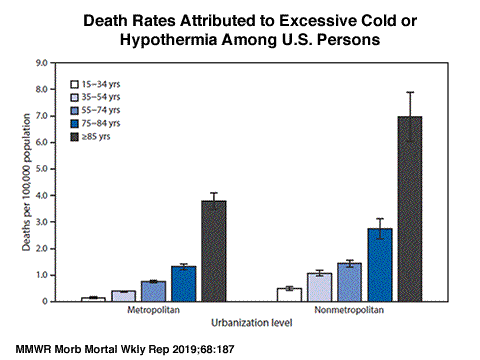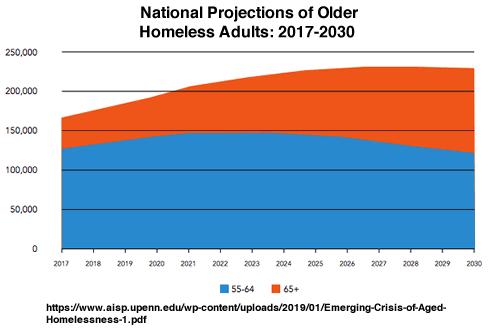Hypothermia
risk factors in the elderly
 Cold weather is especially
risky for the elderly. Hypothermia is defined as the unintentional lowering
of the core body temperature below 95 degree F or 35 degrees C. Hypothermia is a medical emergency that requires immediate attention. Exposure
to excessively
cold temperatures slow the actions of enzymes throughout the body. As a result,
the individual who is hypothermic is at risk of potentially fatal coagulation
disorders, renal failure, and cardiac dysrhythmias.
Cold weather is especially
risky for the elderly. Hypothermia is defined as the unintentional lowering
of the core body temperature below 95 degree F or 35 degrees C. Hypothermia is a medical emergency that requires immediate attention. Exposure
to excessively
cold temperatures slow the actions of enzymes throughout the body. As a result,
the individual who is hypothermic is at risk of potentially fatal coagulation
disorders, renal failure, and cardiac dysrhythmias.
During 2015–2017, death rates attributed to excessive cold or hypothermia increased steadily with age among those aged ≥15 years in both metropolitan and nonmetropolitan counties. The rate for persons aged ≥85 years reached 3.8 deaths per 100,000 in metropolitan counties and 7.3 in nonmetropolitan counties. The lowest rates were among those aged 15–24 years (0.2 in metropolitan counties and 0.5 in nonmetropolitan counties). In each age category, death rates were lower in metropolitan counties and higher in nonmetropolitan counties (QuickStats, 2019).
 Results in three locality were extrapolated to the U.S. as a whole based on 2017 data published in the Annual Homelessness Assessment Report (Culhane, 2019).While this extrapolation should be treated with some caution, as the study localities are not representative of the nation, they suggest that the number of U.S. homeless aged over age 55 could grow to 225,000 by 2026, up from 170,000 in 2017. This growth is mostly driven by a 165% increase in the homeless population 65 and older, from 40,000 in 2017 to 106,000 by 2030.
Results in three locality were extrapolated to the U.S. as a whole based on 2017 data published in the Annual Homelessness Assessment Report (Culhane, 2019).While this extrapolation should be treated with some caution, as the study localities are not representative of the nation, they suggest that the number of U.S. homeless aged over age 55 could grow to 225,000 by 2026, up from 170,000 in 2017. This growth is mostly driven by a 165% increase in the homeless population 65 and older, from 40,000 in 2017 to 106,000 by 2030.
A number of physical factors make the elderly person especially prone to hypothermia,
- Increased heat loss
- Decreased heat production
- Vasodilation
- Drug-induced impairment
Increased heat loss. Hypothermia can occur when heat loss exceeds heat production. Subcutaneous fat acts to retain heat by insulating the muscle and organs from conductive heat loss. Diminished subcutaneous fat on the face and extremities increases the risk of hypothermia in the elderly. Persons in their 80's
and 90's are at high risk for hypothermia when exposed to temperatures below 65 degrees Fahrenheit.
Decreased heat production may occur due to hypothyroidism, hypoglycemia, and starvation or malnutrition.
Another common cause of decreased heat production in the elderly is decreased
muscle activity due to immobility. Pain and depression can lead to reduced physical
activity.
Vasodilation is a major
risk factor for hypothermia in the elderly. Alcohol ingestion produces
peripheral vasodilation, which increases heat loss. General anesthetics also
cause vasodilation. OR nurses and anesthesiologists continuously monitor
and control the patient's core temperature. Certain toxins released during
sepsis can trigger vasodilation which may lead to hypothermia.
Drug-induced impairment: barbiturates, major or minor
tranquilizers, tricyclic antidepressants are all known to have exaggerated effects
in the elderly. These drugs can impair consciousness, dull sensations or cause
the elderly to act inappropriately. Dulled sensations or failure to initiate
protective actions can lead to hypothermic exposure.
Instant
Feedback:
Elderly
people have less subcutaneous fat and, as a result, are more prone to hypothermia
than are younger people
References
QuickStats: Death Rates Attributed to Excessive Cold or Hypothermia Among Persons Aged ≥15 Years, by Urbanization Level and Age Group — National Vital Statistics System, 2015–2017. MMWR Morb Mortal Wkly Rep 2019;68:187. DOI: http://dx.doi.org/10.15585/mmwr.mm6807a8
Culhane, D. et al. (2019). The Emerging Crisis of Aged Homelessness. Philadelphia, PA: UPENN.
©RnCeus.com
 Cold weather is especially
risky for the elderly. Hypothermia is defined as the unintentional lowering
of the core body temperature below 95 degree F or 35 degrees C. Hypothermia is a medical emergency that requires immediate attention. Exposure
to excessively
cold temperatures slow the actions of enzymes throughout the body. As a result,
the individual who is hypothermic is at risk of potentially fatal coagulation
disorders, renal failure, and cardiac dysrhythmias.
Cold weather is especially
risky for the elderly. Hypothermia is defined as the unintentional lowering
of the core body temperature below 95 degree F or 35 degrees C. Hypothermia is a medical emergency that requires immediate attention. Exposure
to excessively
cold temperatures slow the actions of enzymes throughout the body. As a result,
the individual who is hypothermic is at risk of potentially fatal coagulation
disorders, renal failure, and cardiac dysrhythmias. Results in three locality were extrapolated to the U.S. as a whole based on 2017 data published in the Annual Homelessness Assessment Report (Culhane, 2019).While this extrapolation should be treated with some caution, as the study localities are not representative of the nation, they suggest that the number of U.S. homeless aged over age 55 could grow to 225,000 by 2026, up from 170,000 in 2017. This growth is mostly driven by a 165% increase in the homeless population 65 and older, from 40,000 in 2017 to 106,000 by 2030.
Results in three locality were extrapolated to the U.S. as a whole based on 2017 data published in the Annual Homelessness Assessment Report (Culhane, 2019).While this extrapolation should be treated with some caution, as the study localities are not representative of the nation, they suggest that the number of U.S. homeless aged over age 55 could grow to 225,000 by 2026, up from 170,000 in 2017. This growth is mostly driven by a 165% increase in the homeless population 65 and older, from 40,000 in 2017 to 106,000 by 2030.